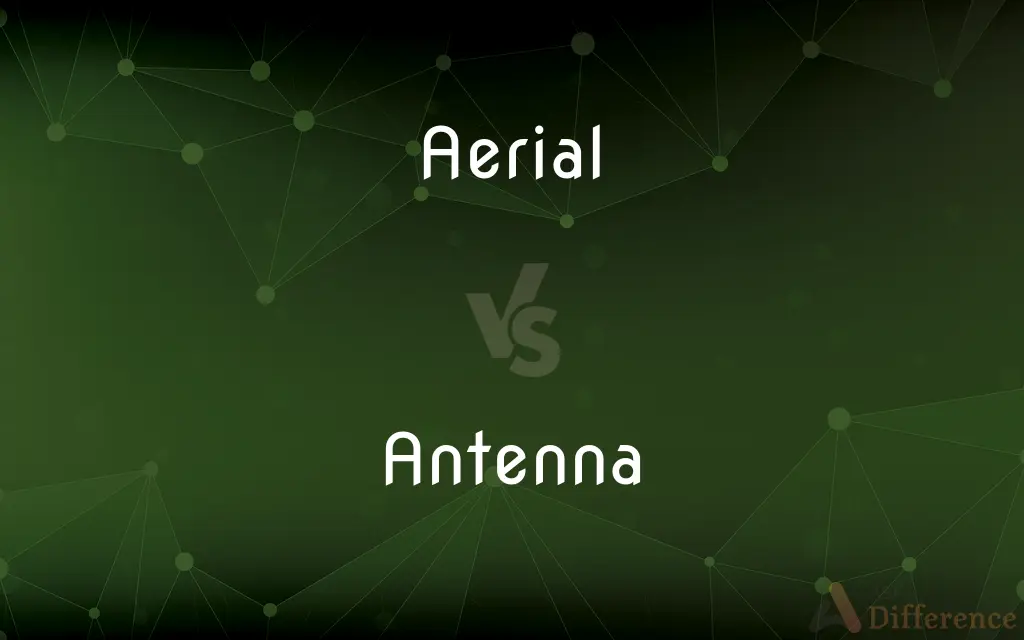Aerial vs. Antenna — What's the Difference?
By Tayyaba Rehman — Updated on October 12, 2023
Aerial refers to things in the air or operating from the air; Antenna is a device for receiving or transmitting signals, often used synonymously with "aerial" in British English.

Difference Between Aerial and Antenna
Table of Contents
ADVERTISEMENT
Key Differences
The terms Aerial and Antenna, although occasionally used interchangeably, primarily hold distinct meanings. Aerial, in its most general sense, pertains to anything related to the air or atmosphere. For instance, aerial creatures refer to those that fly. On the other hand, Antenna specifically denotes a device or structure designed to send or receive electromagnetic waves, such as those used in radio and television broadcasting.
When the discussion revolves around telecommunication devices, especially in British English, Aerial can sometimes be used synonymously with Antenna. This usage can lead to confusion, as both terms converge in this context. In other fields, such as biology, an Antenna refers to a sensory appendage on insects. There is no such biological reference for the term Aerial.
Thus, while Aerial has a broader scope in its application, Antenna has a more technical and specific connotation.
Comparison Chart
Primary Meaning
Related to the air or atmosphere
Device for sending/receiving signals
Usage in Telecommunication
Sometimes synonymous with Antenna (especially in British English)
Common term for signal-receiving apparatus
ADVERTISEMENT
Biological Reference
None
Sensory appendage on insects
General Context
Anything operating from or situated in the air
Specifically a device/structure related to electromagnetic transmission/reception
Scope of Application
Broader
More technical and specific
Compare with Definitions
Aerial
Elevated; lofty.
He has an aerial perspective on the situation.
Antenna
A device to receive or transmit radio or TV signals.
The car's antenna was broken, affecting radio reception.
Aerial
Used in British English to mean Antenna.
The radio's aerial needs to be extended for better reception.
Antenna
A means of being sensitive or responsive to something.
He has a good antenna for detecting lies.
Aerial
Existing, happening, or operating in the air
An aerial battle
An intrepid aerial adventurer
Antenna
A metallic device for radiating or receiving radio waves.
The new phone has multiple antennas for better connectivity.
Aerial
A rod, wire, or other structure by which signals are transmitted or received as part of a radio or television transmission or receiving system.
Antenna
(Zoology) One of the paired, flexible, segmented sensory appendages on the head of an insect, myriapod, or crustacean functioning primarily as an organ of touch.
Aerial
A type of freestyle skiing in which the skier jumps from a ramp and carries out manoeuvres in the air.
Antenna
Something likened to this sensory appendage, as in function or form
Sensitive public relations antennae.
Aerial
Of, in, or caused by the air.
Antenna
A structure in a photosynthetic organism containing pigment molecules that absorb light energy and transfer it to a reaction center composed of proteins and pigments, where the light energy is converted into chemical energy.
Aerial
Existing or living in the air.
Antenna
Pl. an·ten·nas A metallic apparatus for sending or receiving electromagnetic waves such as radio waves.
Aerial
Reaching high into the air; lofty.
Antenna
A feeler organ on the head of an insect, crab, or other animal. 17
Aerial
Suggestive of air, as in lightness; airy.
Antenna
An apparatus to receive or transmit electromagnetic waves and convert respectively to or from an electrical signal.
Aerial
Unsubstantial; imaginary.
Antenna
(figurative) The faculty of intuitive astuteness.
Aerial
Of, for, or by means of aircraft
Aerial photography.
Antenna
(biochemistry) A fragment of an oligosaccharide
Aerial
(Botany) Growing or borne above the ground or water
Aerial roots.
Antenna
(nautical) The spar to which a lateen sail is attached, which is then hoisted up the mast.
Aerial
A radio antenna, especially one suspended in or extending into the air.
Antenna
A movable, articulated organ of sensation, attached to the heads of insects and Crustacea. There are two in the former, and usually four in the latter. They are used as organs of touch, and in some species of Crustacea the cavity of the ear is situated near the basal joint. In insects, they are popularly called horns, and also feelers. The term in also applied to similar organs on the heads of other arthropods and of annelids.
Aerial
An acrobatic maneuver performed in midair, as in skateboarding.
Antenna
A metallic device, variously shaped, designed for the purpose of either transmitting or receiving radio waves, as for radio or television broadcasting, or for transmitting communication signals. Some types are: whip antenna, antenna tower, horn antenna, dish antenna, directional antenna and rabbit ears. See transmitter, receiver.
Aerial
A flip in which the body turns over sideways with the arms and legs spread similar to a cartwheel.
Antenna
An electrical device that sends or receives radio or television signals
Aerial
Living or taking place in the air.
The seabirds put on an astonishing aerial display.
Antenna
Sensitivity similar to that of a receptor organ;
He had a special antenna for public relations
Aerial
Made up of air or gas; gaseous.
Antenna
One of a pair of mobile appendages on the head of e.g. insects and crustaceans; typically sensitive to touch and taste
Aerial
Positioned high up; elevated.
The aerial photographs clearly showed the damage caused by the storm.
Antenna
A sensory appendage in insects.
The butterfly's antenna sensed its environment.
Aerial
Ethereal, insubstantial; imaginary.
Antenna
A set of wires or rods to boost signal reception or transmission.
Adjust the TV's antenna for a clearer picture.
Aerial
Pertaining to the air or atmosphere; atmospheric.
Aerial
(aviation) Pertaining to a vehicle which travels through the air; airborne; relating to or conducted by means of aircraft.
Aerial
(botany) Above the ground
Aerial
A rod, wire, or other structure for receiving or transmitting radio, television signals etc.
Aerial
A move, as in dancing or skateboarding, involving one or both feet leaving the ground.
Aerial
(photography) An aerial photograph.
Aerial
Of or pertaining to the air, or atmosphere; inhabiting or frequenting the air; produced by or found in the air; performed in the air; as, aërial regions or currents; the aërial maneuvers of a fighter plane.
Aerial
Consisting of air; resembling, or partaking of the nature of air. Hence: Unsubstantial; unreal.
Aerial
Rising aloft in air; high; lofty; as, aërial spires.
Aerial
Growing, forming, living, or existing in the air, as opposed to growing or existing in earth or water, or underground; as, aërial rootlets, aërial plants; the aerial roots of a philodendron.
Aerial
Light as air; ethereal.
Aerial
Operating or operated overhead especially on elevated cables.
Aerial
Operating or moving in the air.
Aerial
A pass to a receiver downfield from the passer.
Aerial
A metallic wire, rod, or combination of rods connected to an electronic device, designed to send or receive radio or television signals.
Aerial
A pass to a receiver downfield from the passer
Aerial
An electrical device that sends or receives radio or television signals
Aerial
In or belonging to the air or operating (for or by means of aircraft or elevated cables) in the air;
Aerial particles
Small aerial creatures such as butterflies
Aerial warfare
Aerial photography
Aerial cable cars
Aerial
Growing in air;
Aerial roots of a philodendron
Aerial
Characterized by lightness and insubstantiality; as impalpable or intangible as air;
Figures light and aeriform come unlooked for and melt away
Aerial fancies
An airy apparition
Physical rather than ethereal forms
Aerial
Pertaining to the air or atmosphere.
Birds have an aerial mode of life.
Aerial
Existing or operating in the air.
The aerial display by the fighter jets was impressive.
Aerial
Resembling or suggestive of the air.
Her dance had an aerial grace to it.
Common Curiosities
In what context is an Antenna used in biology?
In biology, an Antenna refers to a sensory appendage on insects.
Are Aerial and Antenna interchangeable terms?
In telecommunication contexts in British English, they can be, but they have distinct primary meanings.
Can Aerial refer to TV or radio signal reception?
In British English, Aerial can mean a TV or radio Antenna.
Can an Antenna refer to anything aerial?
Not generally. An Antenna specifically relates to signal reception or transmission.
Are all Antennas used for communication?
Most are, but in biology, they're sensory structures on insects.
Can a device have multiple Antennas?
Yes, some devices have multiple antennas for various functions or improved reception.
Do both terms originate from the same language?
No, "Aerial" comes from Latin "aerius" (related to air) and "Antenna" from Latin "antemna" (sail yard).
What does Aerial commonly refer to?
Aerial typically refers to things related to the air or atmosphere.
Is the term Aerial ever used in biology?
Not in the same way as Antenna. Aerial doesn't have a biological reference like Antenna does for insects.
Is Aerial used in American English to refer to a radio device?
Rarely. In American English, "Antenna" is the preferred term.
Can the term Aerial refer to flight or things flying?
Yes, Aerial can pertain to anything related to or operating in the air.
Do all devices with wireless capabilities have Antennas?
Typically, yes. Any device that sends/receives wireless signals has an Antenna.
What's the primary purpose of a TV Aerial or Antenna?
To receive broadcast signals for the television.
Are Aerials always visible on devices?
No, some modern devices have internal Aerials or Antennas.
Can an Aerial or Antenna boost the range of a device's signals?
Yes, they're designed to enhance the sending and receiving capabilities of signals.
Share Your Discovery

Previous Comparison
Autocoprophagy vs. Coprophagy
Next Comparison
Gloss vs. SatinAuthor Spotlight
Written by
Tayyaba RehmanTayyaba Rehman is a distinguished writer, currently serving as a primary contributor to askdifference.com. As a researcher in semantics and etymology, Tayyaba's passion for the complexity of languages and their distinctions has found a perfect home on the platform. Tayyaba delves into the intricacies of language, distinguishing between commonly confused words and phrases, thereby providing clarity for readers worldwide.















































